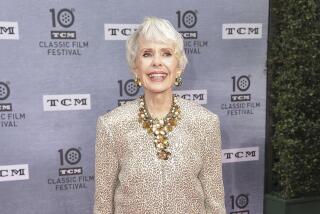Nancy Malone, longtime actress and pioneering TV director, dies at 79
Nancy Malone was on the cover of Life magazine at age 11, had a starring role on Broadway at 17 and worked steadily as an actress in television in her 20s and 30s.
Though she was in demand, she feared for the future. “I’d seen actresses getting to the age of 45, having nowhere to go except Bloomingdale’s or regional theater,” Malone said in an interview for the 2002 book “Women Who Run the Show.”
She drastically curbed her acting in the 1970s for the other side of the camera. Malone became not only an Emmy-winning producer and studio executive, but also — in a move highly unusual for a woman at the time — a director, working on shows such as “Dynasty,” “Cagney & Lacey” and “Star Trek: Voyager.”
Malone, 79, died Thursday at City of Hope National Medical Center in Duarte. The cause was pneumonia that arose from complications of leukemia, said publicist Harlan Boll.
Although Malone credits several men with helping her make the transitions in her career, she also keenly felt the prejudice against women. In the mid-1970s, Malone was made a vice president for television at 20th Century Fox, but not on a level playing field.
“The guys made more money than me, and I was doing the same job,” she said in a 2010 interview recorded by the Academy of Television Arts & Sciences. In her early years as a producer, some directors and crew members would hardly talk to her.
It led her to become a founding member of the Women In Film support and networking group in 1973.
“It is very hard to grasp now, but there was absolutely no place for women to meet to talk about our ambitions or about improving our working lives,” she said in “Women Who Run the Show,” written by Mollie Gregory.
“The guys were helping each other,” Malone continued. “We all saw how the guys went into the men’s room and came out with a deal. How do we find a way to move up without using the men’s room?”
She was born Ann Maloney on March 19, 1935, in Queens Village on Long Island in New York. When she was in grade school, photos of her taken as a lark (it was supposed to be her brother’s photo session) led to her being signed by a prominent modeling agency. With her hair in pigtails, she was the cover girl on the 10th anniversary issue of Life in 1946. As she got radio work, an agent suggested she change her name.
Taking acting seriously as a teenager, Malone studied at the famed Actors Studio. In 1952 she had the title role in the Broadway comedy “Time Out for Ginger.” In addition to theater, she got work in early television, sometimes simultaneously. At one point she was on the live soap opera “The Guiding Light,” filming scenes for her costarring role in the TV series “The Naked City” and appearing in a play, all in the same day.
Malone moved to Los Angeles in 1965 and the work continued to pour in, with roles on “The Fugitive,” “The Andy Griffith Show,” “Hawaii Five-O” and other hits. She was disappointed, however, in many of the roles offered women. “I just can’t wrap my mouth around ‘How-do-you-want-your-coffee-darling?’ once more,” she told TV executive Tom Moore in 1970, as reported in the Gregory book. He was forming an independent company and offered her a job.
She eventually made the leap, learning the producing end of the business. The first TV film she produced was 1975’s “Winner Take All” with Shirley Jones, about a woman with a gambling addiction. It was a ratings hit on NBC, leading to the job at Fox where she stayed for three years. Back on her own, she produced the 1978 TV movie about divorce, “Like Mom, Like Me,” starring Linda Lavin, and other films.
After a bad experience with a director, she sought to learn that side of the business. She studied serious films — “I knew every shot in every Bergman film,” she said in the Academy interview — and made a short at the American Film Institute. She and her close friend Linda Hope, daughter of Bob Hope, raised the money to make a low-budget drama about Alzheimer’s disease: “Those Were Times, Dear.” It aired on PBS in 1985, and that led to Malone getting a TV director’s prize: an episode of “Dynasty.”
She directed 15 more episodes of that show and worked as a director into the mid-2000s. Malone returned to producing for the 1993 TV special “Bob Hope: The First 90 Years,” for which she won an Emmy.
Actress Tyne Daly, who was directed by Malone in “Cagney & Lacey,” said she always kept things light. “She brought the most energetic and enthusiastic spirit to the set and managed to keep it through all of the long, long days,” Daly said in a statement. But the lightness in tone didn’t mean Malone wasn’t serious about the work.
“She was a true believer,” Daly said, “but she was nobody’s fool.”
Malone has no immediate survivors.
More to Read
Start your day right
Sign up for Essential California for the L.A. Times biggest news, features and recommendations in your inbox six days a week.
You may occasionally receive promotional content from the Los Angeles Times.







